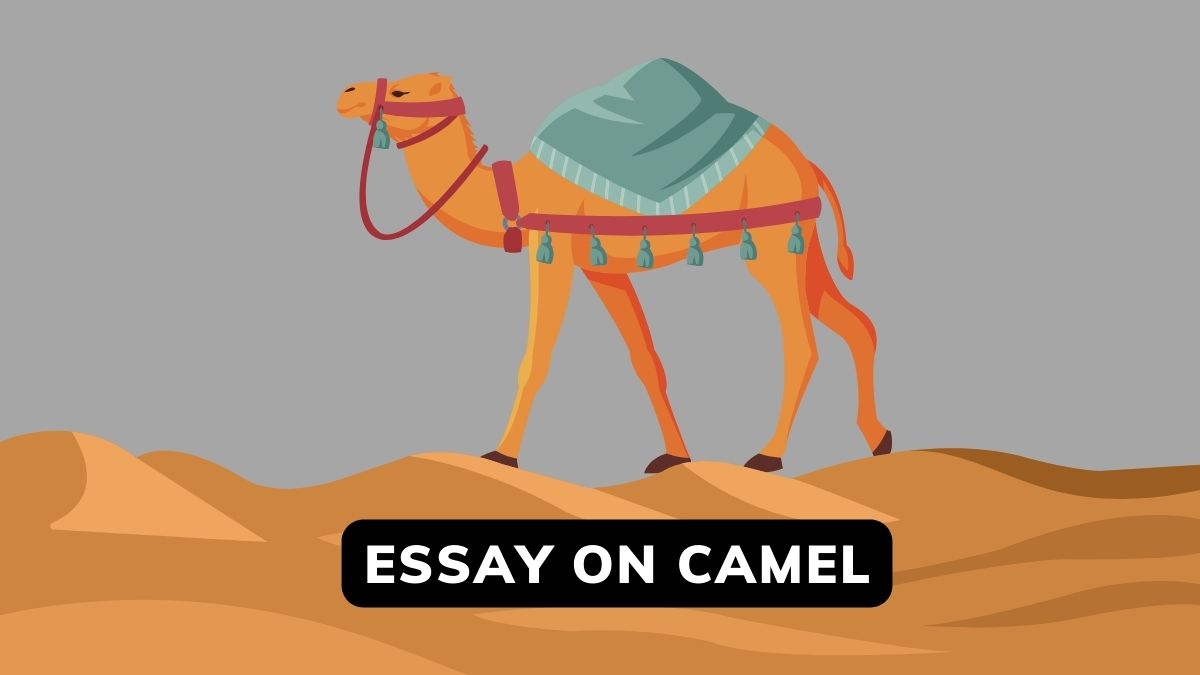Essay On Camel In English, For Kids,100-200 Words
Essay On Camel For Kids
Camels are fascinating animals known for their ability to live in deserts, where very few animals can survive. This essay will introduce you to these wonderful creatures and their unique features.
Camels are large animals with long necks, skinny legs, and one or two humps on their backs. These humps are very special because they store fat, which the camel can use for energy when food is scarce. Think of them like natural backpacks filled with food! Depending on the type of camel, it might have one hump or two. The ones with a single hump are called dromedaries, while the ones with two humps are known as Bactrian camels.
One of the most amazing things about camels is how they have adapted to live in the desert. They can go for a long time without drinking water, which is quite handy in a place where water is hard to find. When they do find water, they can drink lots of it very quickly. Their large feet help them not to sink into the sand, making them excellent desert walkers.
Camels are not just good at dealing with the hot desert day; they are also well-equipped for the chilly desert nights. Their thick fur keeps them warm when the temperature drops. Plus, their long eyelashes and closable nostrils keep the sand out during sandstorms.
These animals are very useful to people who live in deserts. For thousands of years, people have relied on camels for transportation, carrying goods across vast deserts where vehicles cannot go. Besides being a mode of transport, camels also provide milk, which is a vital source of nutrition for desert communities, and their fur can be used to make textiles.
Kids, next time you see a picture of a camel, remember that they are not just animals with humps; they are survivors equipped with amazing features to live in one of the most challenging environments on Earth. They are truly special creatures of the animal kingdom.
Essay On Camel 100 Words
The camel, often called the “ship of the desert,” is an extraordinary animal known for its ability to navigate the vast and harsh desert landscapes. Adaptable to extreme conditions, camels can go for days without water thanks to their unique physiological traits. They possess humps on their backs, which store fat, providing energy when food is scarce. Not just a single species, camels come in two types: the one-humped dromedary, common in Africa and the Middle East, and the two-humped Bactrian, found in Central Asia. These hardy creatures are not only vital for desert communities for transportation but also for their milk, meat, and wool. Camels have a calm demeanor and are incredibly resilient, making them indispensable companions in arid regions around the world. Their remarkable adaptations to their environment highlight the wonders of nature’s ingenuity.
Essay On Camel 200 Words
Camels, often known as the ships of the desert, are fascinating creatures that have intrigued humans for thousands of years. These resilient animals are perfectly adapted to life in some of the harshest environments on Earth. Camels come in two main types: the one-humped dromedary, common in Africa and the Middle East, and the two-humped Bactrian, found in Central Asia’s cold deserts.
Remarkably, camels can travel long distances over deserts with little to no water. This is because they store fat in their humps, which can be converted into water and energy when resources are scarce. They are also equipped with thick coats that protect them from the desert heat, and their long eyelashes and sealable nostrils keep sand out during storms.
Camels are more than just desert dwellers; they have been domesticated for over 3,000 years, providing transportation, milk, meat, and wool. These animals are known for their endurance and ability to carry heavy loads, making them invaluable to the inhabitants of desert regions.
Despite their association with arid landscapes, camels are social animals that live in groups called herds. With a life span of 40 to 50 years, camels form lasting bonds with their herd members.
In conclusion, camels are remarkable for their adaptations to desert life. Their significance goes beyond being mere subjects of curiosity; they play a crucial role in the livelihoods of many people in desert regions around the world. Understanding these creatures helps us appreciate the delicate balance of desert ecosystems and the remarkable ways in which life adapts to challenging environments.
Essay On Camel In English
Camels, often referred to as the “ships of the desert,” stand as a testament to nature’s ingenuity, perfectly adapted to the arduous life of desert environments. This essay delves into the fascinating world of camels, shedding light on their unique physical features, survival mechanisms, and the pivotal role they play in human societies across desert landscapes.
Physical Features and Adaptations
The camel’s physique is a marvel of evolutionary adaptation, designed to navigate the extreme conditions of the desert. Among their most notable features are their long, slender legs and wide, padded feet, which enable them to tread softly on sand without sinking. The camel’s most distinctive characteristic, however, is its hump or humps (one in dromedaries, two in Bactrian camels), which are reservoirs of fatty tissue. Contrary to the common misconception, these humps do not store water. Instead, they provide a concentrated source of energy that camels can metabolize when food is scarce.
The camel’s ability to thrive in the desert extends beyond its humps. Their nostrils can close to keep out sand during storms, and their long eyelashes and bushy eyebrows protect their eyes from the harsh sun and blowing sand. Moreover, their thick fur insulates them from daytime heat and night-time cold, while their unique oval-shaped red blood cells facilitate circulation even in a dehydrated state.
Survival Mechanisms
Camels possess remarkable physiological mechanisms that allow them to withstand the challenges of desert living. They can consume up to 40 gallons of water in one go and have the extraordinary ability to fluctuate their body temperature to conserve water, reducing the need for sweating. This means a camel can lose a substantial portion of its body weight through dehydration without succumbing to the effects, a feat unmatched by most other animals.
Furthermore, camels can survive by feeding on dry, thorny vegetation that other herbivores would avoid, thanks to their tough mouths. Their digestive system is incredibly efficient, allowing them to extract maximum moisture and nutrients from their food, producing dry feces and concentrated urine to minimize water loss.
Role in Human Societies
For centuries, camels have been indispensable to the livelihoods of nomadic peoples across the Sahara, the Middle East, and Asia. They have served as modes of transportation, carrying goods and people across vast stretches of inhospitable terrain. Camels are also a source of nutrition, providing milk that is rich in vitamins, meat for sustenance, and fur and hide for clothing and shelter. In modern times, while technology has replaced camels in some of their traditional roles, they remain a cultural symbol and a tourist attraction in many parts of the world. Additionally, research into camels’ unique immune systems and the properties of their milk may offer new medical insights.
Conclusion
Camels are a symbol of resilience and adaptability, embodying the essence of desert life. Their evolutionary adaptations and survival mechanisms allow them not only to endure but to thrive in some of the planet’s most challenging environments. Beyond their biological and ecological significance, camels have been and continue to be, invaluable companions to human societies, enabling the habitation and exploration of arid landscapes. As we advance in our understanding of these remarkable creatures, we uncover more ways in which camels contribute not just to the survival of humans in desert regions but to scientific advancements that can benefit all of humanity.







